Posted by: rring in Tours

The Watkinson is a favorite stop for those touring the College Library, and we have given half a dozen tours this summer to kids from the magnet school across the street from Trinity. Most of these middle school kids shuffle through without asking questions, but I often hear later that they are really interested. Certainly the highpoint this year is our demonstration of a 1920’s victrola that we do–it is amazing for them to see a non-electronic device produce music fit to dance to! See the play in action on our previous post.
Comments Off on School tours
 On Sunday we hosted representatives from two regional bibliophile groups–the American Printing History Association, New England Chapter (APHA NE) and the American Book Collectors of Children’s Books (ABC’s)–and printed a keepsake for them to take back to their members. From left to right, Phil Weimerskirch (APHA), Alice Beckwith (APHA), John Renjilian (APHA/ABC), Caroline Hardy (ABC), and Nancy Rossi (Trinity guest and new member of APHA). Along with a tour of the stacks, we presented an array of fine press books from our impressive collection, as well as some of our “high spots,” like the first edition of the King James Bible (1611), which is open on the table.
On Sunday we hosted representatives from two regional bibliophile groups–the American Printing History Association, New England Chapter (APHA NE) and the American Book Collectors of Children’s Books (ABC’s)–and printed a keepsake for them to take back to their members. From left to right, Phil Weimerskirch (APHA), Alice Beckwith (APHA), John Renjilian (APHA/ABC), Caroline Hardy (ABC), and Nancy Rossi (Trinity guest and new member of APHA). Along with a tour of the stacks, we presented an array of fine press books from our impressive collection, as well as some of our “high spots,” like the first edition of the King James Bible (1611), which is open on the table.
The keepsake was printed at Hartford Prints!, our new best friend for letterpress things, and features the Watkinson logo bearing one of the basic tenets of our field, “Book openeth book.”
Comments Off on Bookish visitors
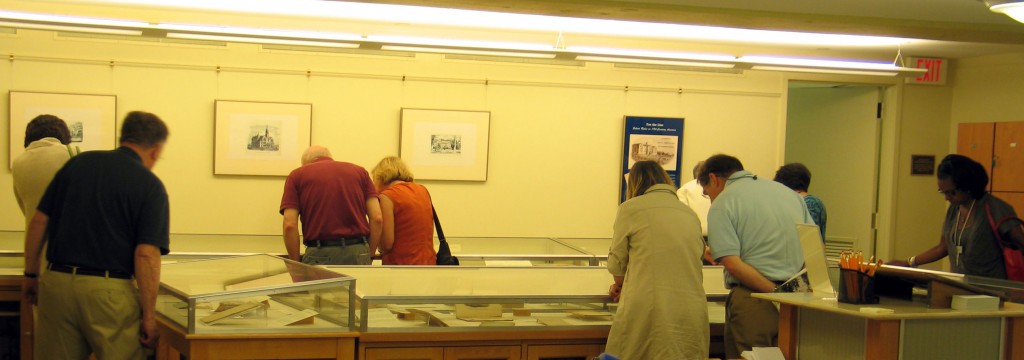

We have been thrilled to see a steady stream of folks from the Country Day School Headmaster’s Association conference, hosted at Trinity between June 18-21. Over 40 of the ca. 150 participants have found their way to the Watkinson (some ditched a session), and many have expressed delight and interest in our exhibition. Here are some of the comments from our guestbook:
“Some things endure–fewer rules are better!”
“Thank you for putting it together–lots to read and think about.”
“This is fabulous!”
“Enlightening & delightful exhibit!”
“Wonderful collection!”
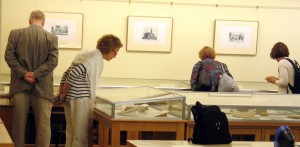
Comments Off on Toe the Line exhibition a hit!
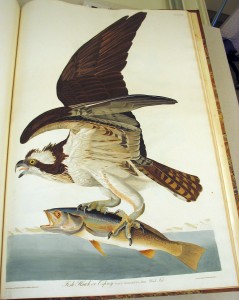 “The Fish Hawk may be said to be of mild disposition. Not only do these birds live in perfect harmony together, but they even allow other birds of very different character to approach so near to them as to build their nests of the very materials of which the outer parts of their own are constructed. I have never observed a Fish Hawk chasing any other birds whatever. So pacific and timorous is it, that, rather than encounter a foe but little more powerful than itself, it abandons its prey to the White-headed Eagle, which, net to man, is its greatest enemy . . .
“The Fish Hawk may be said to be of mild disposition. Not only do these birds live in perfect harmony together, but they even allow other birds of very different character to approach so near to them as to build their nests of the very materials of which the outer parts of their own are constructed. I have never observed a Fish Hawk chasing any other birds whatever. So pacific and timorous is it, that, rather than encounter a foe but little more powerful than itself, it abandons its prey to the White-headed Eagle, which, net to man, is its greatest enemy . . .
The Fish Hawk differs from all birds of prey in another important particular, which is, that it never attempts to secure its prey in the air, although its rapidity of flight might induce an observer to suppose it perfectly able to do so. I have spent weeks on the Gulf of Mexico, where these birds are numerous, and have observed them sailing and plunging into the water, at a time when numerous shoals of flying-fish were emerging from the sea to evade the pursuit of the dolphins. Yet the Fish Hawk never attempted to pursue any of them while above the surface, but would plunge after one of them or a bonita-fish, after they had resumed their usual mode of swimming near the surface.”
–J. J. Audubon, Ornithological Biography, I (1831), 415-16 [excerpted].
Comments Off on The Fish Hawk, or Osprey (Audubon “bird of the week”)
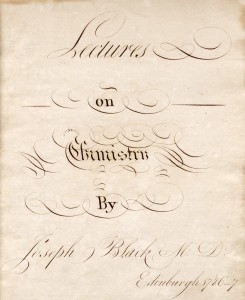 Here’s a great example of what you can find just browsing. Looking for a patron at what we had on chemistry, I came across a four-volume set of manuscript notes (possibly by a professional copyist) with the title-page “Lectures on Chemistry by Joseph Black, M.D., Edinburgh 1786-7.” It seems that we have a fair copy of Black’s lecture notes, taken by William P. Maxwell, one of his students. Apparently many copies of manuscript notes on Black’s lectures, taken by his students, were in circulation at the time–some of which were better than others. According to one source:
Here’s a great example of what you can find just browsing. Looking for a patron at what we had on chemistry, I came across a four-volume set of manuscript notes (possibly by a professional copyist) with the title-page “Lectures on Chemistry by Joseph Black, M.D., Edinburgh 1786-7.” It seems that we have a fair copy of Black’s lecture notes, taken by William P. Maxwell, one of his students. Apparently many copies of manuscript notes on Black’s lectures, taken by his students, were in circulation at the time–some of which were better than others. According to one source:
“Joseph Black (1728-1799) was Professor of Chemistry at the Universities of Glasgow (1756-66) and Edinburgh (1766-99). Immediately after his death, his executors decided to publish his lectures from his manuscript notes. This step was taken as they were informed that publication was proposed from notes taken by his students . . . The best of these was considered so unworthy of Black that the executors wished to prevent the inadequate impression of his knowledge and talents which such a publication would make.”
 John Robinson, Professor of Natural Philosophy at Edinburgh and a former student of Black, was chosen to compile and edit the lectures, which were published in 1803. We have in the Watkinson the first American edition (Philadelphia, 1807), which (interestingly) contains a list of 138 named subscribers, who ordered 528 copies, all told (the largest order by far was from Birch & Small, 200 copies). Another factoid of interest is that this copy was formerly owned by George Brinley, Jr. (1817-1875), the great Americana collector, who was a founding Trustee and second President of the Watkinson Library (75 years before it came to Trinity College). Brinley gave this set to Trinity in 1842.
John Robinson, Professor of Natural Philosophy at Edinburgh and a former student of Black, was chosen to compile and edit the lectures, which were published in 1803. We have in the Watkinson the first American edition (Philadelphia, 1807), which (interestingly) contains a list of 138 named subscribers, who ordered 528 copies, all told (the largest order by far was from Birch & Small, 200 copies). Another factoid of interest is that this copy was formerly owned by George Brinley, Jr. (1817-1875), the great Americana collector, who was a founding Trustee and second President of the Watkinson Library (75 years before it came to Trinity College). Brinley gave this set to Trinity in 1842.
It might be a fascinating project for a student to compare our copy of the lecture notes with the published version, as a book history project.
Sources:
“Joseph Black’s Lectures on the Elements of Chemistry” Isis 25:2 (Sept. 1936), 372-90
Comments Off on Great chemistry!
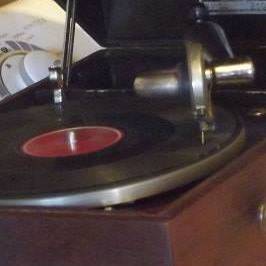 Staffer Henry Arneth picked up a working portable Victrola last weekend while antiquing in Vermont. We will feature it in the fall exhibition celebrating the gift of the Rubenstein collection of musical recordings.
Staffer Henry Arneth picked up a working portable Victrola last weekend while antiquing in Vermont. We will feature it in the fall exhibition celebrating the gift of the Rubenstein collection of musical recordings.
Click here for a short video of the player in action:
Heat wave
Comments Off on Jump & Jive!
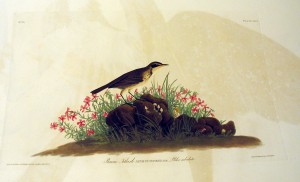 “I shot two of these birds whilst traversing one of the extensive prairies of our North-western States. Five of them had been running along the foot-path before me, for some time. I at first looked upon them as of the Common Brown Titlark species (Anthus Spinoletta), but as they rose on the wing, the difference of their notes struck me, and, shooting at them, I had the good fortune to kill two, which I discovered, on examination, to be of a new and distinct species, although in the general appearance of their plumage they were very nearly allied to the Brown Titlark. The rest I pursued in vain, and was forced to abandon the chase on account of the approach of night, and the necessity of preparing for a rest after a long walk.”
“I shot two of these birds whilst traversing one of the extensive prairies of our North-western States. Five of them had been running along the foot-path before me, for some time. I at first looked upon them as of the Common Brown Titlark species (Anthus Spinoletta), but as they rose on the wing, the difference of their notes struck me, and, shooting at them, I had the good fortune to kill two, which I discovered, on examination, to be of a new and distinct species, although in the general appearance of their plumage they were very nearly allied to the Brown Titlark. The rest I pursued in vain, and was forced to abandon the chase on account of the approach of night, and the necessity of preparing for a rest after a long walk.”
–J. J. Audubon, Ornithological Biography, I (1831), 408 [excerpted].
Comments Off on The Prairie Titlark (Audubon “bird of the week”)
 “The Tyrant Fly-catcher, or, as it is commonly named, the Field Martin, or King Bird, is one of the most interesting visitors of the United States, where it is to be found during spring and summer, and where, were its good qualities appreciated as they deserve to be, it would remain unmolested. But man being generally disposed to consider in his subjects a single fault sufficient to obliterate the remembrance of a thousand good qualities, even when the latter are beneficial to his interest, and tend to promote his comfort, persecutes the King Bird without mercy, and extends his enmity to its whole progeny. This mortal hatred is occasioned by a propensity which the Tyrant Fly-catcher now and then shews to eat a honey-bee, which the narrow-minded farmer looks upon as exclusively his own property, although he is presently to destroy thousands of its race, for the selfish purpose of siezing upon the fruits of their labours, which he does with as little remorse as if nature’s bounties were destined for man alone.”
“The Tyrant Fly-catcher, or, as it is commonly named, the Field Martin, or King Bird, is one of the most interesting visitors of the United States, where it is to be found during spring and summer, and where, were its good qualities appreciated as they deserve to be, it would remain unmolested. But man being generally disposed to consider in his subjects a single fault sufficient to obliterate the remembrance of a thousand good qualities, even when the latter are beneficial to his interest, and tend to promote his comfort, persecutes the King Bird without mercy, and extends his enmity to its whole progeny. This mortal hatred is occasioned by a propensity which the Tyrant Fly-catcher now and then shews to eat a honey-bee, which the narrow-minded farmer looks upon as exclusively his own property, although he is presently to destroy thousands of its race, for the selfish purpose of siezing upon the fruits of their labours, which he does with as little remorse as if nature’s bounties were destined for man alone.”
–J. J. Audubon, Ornithological Biography, I (1831), 403 [excerpted].
Comments Off on The Tyrant Fly-catcher (Audubon “bird of the week”)
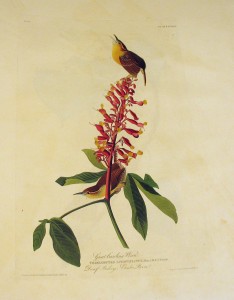 “The quickness of the motions of this active little bird is fully equal to that of the mouse. Like the latter, it appears and is out of sight in a moment, peeps into a crevice, passes rapidly through it, and shews itself at a different place the next instant. When satiated with food, or fatigued with these multiplied exertions, the little fellow stops, droops its tail, and sings with great energy a short ditty something resembling the words come-to-me, come-to-me, repeated several times in quick succession, so loud, and yet so mellow, that it is always agreeable to listen to them. During spring, these notes are heard from all parts of the plantations, the damp woods, the swamps, the sides of creeks and rivers, as well as from the barns, the stables and the piles of wood, within a few yards of the house.”
“The quickness of the motions of this active little bird is fully equal to that of the mouse. Like the latter, it appears and is out of sight in a moment, peeps into a crevice, passes rapidly through it, and shews itself at a different place the next instant. When satiated with food, or fatigued with these multiplied exertions, the little fellow stops, droops its tail, and sings with great energy a short ditty something resembling the words come-to-me, come-to-me, repeated several times in quick succession, so loud, and yet so mellow, that it is always agreeable to listen to them. During spring, these notes are heard from all parts of the plantations, the damp woods, the swamps, the sides of creeks and rivers, as well as from the barns, the stables and the piles of wood, within a few yards of the house.”
–J. J. Audubon, Ornithological Biography, I (1831), 399 [excerpted].
Comments Off on The Great Carolina Wren (Audubon “bird of the week”)

We were thrilled to see over 70 people (families and friends of graduating seniors) come through the Watkinson today! On display is, of course, the famous Audubon (Birds of America), several books recently acquired and given (including the 2nd Folio of Shakespeare), as well as a small student exhibition and the main exhibit on Hyam Plutzik.

Comments Off on Commencement weekend!
 On Sunday we hosted representatives from two regional bibliophile groups–the American Printing History Association, New England Chapter (APHA NE) and the American Book Collectors of Children’s Books (ABC’s)–and printed a keepsake for them to take back to their members. From left to right, Phil Weimerskirch (APHA), Alice Beckwith (APHA), John Renjilian (APHA/ABC), Caroline Hardy (ABC), and Nancy Rossi (Trinity guest and new member of APHA). Along with a tour of the stacks, we presented an array of fine press books from our impressive collection, as well as some of our “high spots,” like the first edition of the King James Bible (1611), which is open on the table.
On Sunday we hosted representatives from two regional bibliophile groups–the American Printing History Association, New England Chapter (APHA NE) and the American Book Collectors of Children’s Books (ABC’s)–and printed a keepsake for them to take back to their members. From left to right, Phil Weimerskirch (APHA), Alice Beckwith (APHA), John Renjilian (APHA/ABC), Caroline Hardy (ABC), and Nancy Rossi (Trinity guest and new member of APHA). Along with a tour of the stacks, we presented an array of fine press books from our impressive collection, as well as some of our “high spots,” like the first edition of the King James Bible (1611), which is open on the table.












